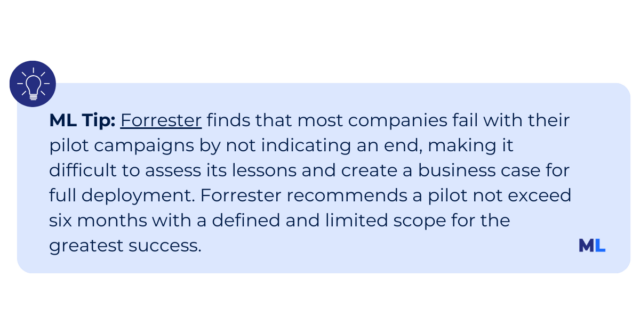
Unlock Global ABM at Scale — Madison Logic strengthens ABM reach with Connected TV and Audio expansion globally. Learn More
Unlock Global ABM at Scale — Madison Logic strengthens ABM reach with Connected TV and Audio expansion globally. Learn More

Eager to launch and grow your account-based marketing (ABM) program?
Here’s the catch: ABM can be expensive, time-consuming, and challenging to get right. Your team is stretched thin, budget is tight, and not everyone in the organization may see the value of an account-based approach (just yet). Garnering support to implement ABM can be tough, with 37% of marketers reporting difficulty obtaining sufficient resources for ABM initiatives.
That’s where a pilot strategy comes in.
An ABM pilot is a great way to test run a campaign for wider adoption and investment of a larger account-based program. By starting small, you can unlock key benefits that contribute to a more successful ABM strategy, including:
Marketers often jump full force into ABM campaigns without a framework to ensure they maximize their resources. Pilots are only as good as the framework they work within. Dedicating time and resources to ensuring your pilot campaign is well planned out and set up for success is important.
Here are the six steps to implement an ABM pilot strategy that drives higher success:
Internal buy-in starts with a solid plan. To gain the necessary support from key stakeholders, you must present a clear and well-organized approach of your ABM pilot, making it easy for them to understand how it works and why it matters.
Begin by outlining the framework and approach for your ABM pilot, including clearly defined goals, key performance indicators (KPIs), and a timeline for the campaign to ensure your pilot remains well-structured and focused. Ask yourself the following questions to construct your outline:
Define specific, measurable goals that align with your overall business objectives. Whether it’s generating new leads, engaging key accounts, or increasing pipeline velocity, having a well-defined goal ensures that your efforts are focused and that you can accurately measure success. Clear goals not only guide your strategy but also make it easier to demonstrate the value of your pilot to stakeholders. When you focus on the storytelling around your pilot program—as in, ensuring you can explain your campaign strategy with KPIs and metrics that clearly tie back to your overall goals—you’re able to collect data-driven insights that lead to actionable optimizations for future campaigns and, ideally, more investment in your marketing motions.
Once you identify your goals, set clear ABM KPIs aligned with those goals so you can easily measure success and benchmark against your efforts. When running a small pilot program, keep everything scaled down so you can measure results accurately. If you’re trying to prove to leadership that this approach works, make it straightforward by choosing specific, tangible KPIs that directly reflect your success and growth opportunities.
For example, if your goal is to create opportunities, consider how long your sales cycle typically takes. If your sales cycle is 18 months, and you’re running a short pilot, you’re unlikely to see closed-won revenue within the pilot’s timeframe. Instead, focus on KPIs that can be realistically measured during the pilot, such as lead generation or early-stage engagement metrics.
Your goals and KPIs inform your campaign’s timeline. For instance, lead generation can be an ongoing process, while goals like opportunity creation are influenced by the length of your sales cycle, which is benchmarked around your company’s growth stage, industry, and offering.

Earlier this year, the Madison Logic Marketing Team ran a pilot campaign with the goal of increasing current spend within our top customer accounts. We kept our goal extremely specific, ensuring efforts were both targeted and measurable.
By targeting a specific group of high-value customers, we were able to tailor our strategies and resources effectively, closely monitoring KPIs such as customer engagement and research activity. This focused approach allowed us to optimize our pilot in real-time, providing leadership with clear insights that directly tied the efforts to an increase in customer spend and gain their buy-in for a wider campaign activation.
Understanding the audience you’re trying to reach helps inform campaign messaging and targeting strategies. This is not a best-guess exercise; you need data to be honest about choosing in-market accounts. Combining your first-party data through customer relationship management (CRM) and marketing automation systems with third-party buyer intent data will uncover insights you probably didn’t know, like:
Use these insights to identify the accounts that are best positioned to support your KPIs. For example, if your pilot’s focus is on net-new acquisition, look for accounts that are surging on product topics, showing interest in your competitors, or fitting within your ideal customer profile (ICP). Based on this data, you can build a targeted list of high-potential accounts.
With ML Insights, marketers can uncover the accounts with the highest propensity to purchase. For free access to these intent-based insights, check out our collection of ABM Buyer Intent Guides.
ABM enables marketers to select the appropriate channels, content formats, and engagement strategies to build trust and relationships with their target audience. Developing this trust requires a personalized experience that delivers the right message, to the right person, at the right time.
At the initial stages of your ABM pilot, you might want to focus on a single channel, such as:
A targeted single channel approach allows you to refine your messaging and strategies before scaling. However, since buyers rarely focus their research on just one site, it’s crucial to engage all members of the buying committee across multiple channels. To effectively reach and influence your target accounts, you’ll need a multi-channel strategy that covers the places they spend their time online. Once you’ve established success with one channel, you can continue to expand with other channels, enhancing your overall approach.
When implementing a multi-channel pilot, it’s crucial to structure each channel around your audience. Tailor your approach to fit the preferences and behaviors of your target accounts, ensuring that each channel delivers personalized and relevant content. For example, consider content syndication as a means to reach a broader industry segment. You can use display advertising to retarget potential leads who interacted with your content, whether through organic means or your content syndication efforts. And knowing that these accounts are on social media, leverage LinkedIn Ads to not only encourage social engagement, but as a means to re-engage with any content they’ve interacted with. The result of this unified, multi-channel approach is a higher awareness of what accounts and buyers are engaging with your content, which can lead to more campaigns that drive demand, resulting in, ideally, faster sales cycles.
The best marketers continue to experiment and develop existing strategies.
After establishing a pilot, keep building on it. For example, you can run a pilot within an existing campaign or use it to enhance your current ABM efforts. By integrating new pilots with your ongoing strategies, you can further grow and refine your approach.
ABM, when used with a full-funnel, multi-channel approach, provides potential customers with a comprehensive and consistent experience throughout the buying journey, from initial awareness of a problem to post-purchase engagement. When marketers use a full-funnel strategy, they build their organization’s reputation from start to finish and beyond in the customer relationship and keep their brand and content top of mind.
Once you’ve identified your audience and strategy, the next question is, “Do you have the content to support the buying committee?”
When developing ABM content and messaging, it’s essential that everything aligns with the original goal of your pilot. For example, if your goal is to target net-new prospects who may not be familiar with your brand, you need to focus on educating them. Ask yourself, “What top-of-funnel content assets do we have available that can effectively introduce our brand? And what assets drive demand mid- or bottom of the funnel?” Consider your buyer personas, buying committee’s unique needs, and levels of seniority. You need to evaluate whether you have the right content to support these specific personas and where they are within the funnel.
For example, high-level executives focus on the strategic implementation of an investment. They want to see how the solution aligns with the company’s vision, improves competitive advantage, and drives growth. Finance and procurement individuals are interested in the total cost of ownership, pricing models, and potential savings, while IT managers want to know how a solution fits into an existing technology stack. Ensuring your content and messaging speaks to these pain points and concerns helps you establish a deeper connection with each of these specific decision-makers.
Like much of B2B marketing and sales, implementing an ABM pilot requires strong teamwork.
Once you create your pilot strategy, get feedback from sales. You want to be extremely clear with what you are communicating to them to ensure both teams are on the same page. Prepare to discuss:
Their input may lead to adjustments in your campaign, such as refining your account lists, altering content, or changes in channel strategy. Once you make any adjustments, circle back to ensure everyone agrees on the pilot plan and approach. It’s key to have a consistent feedback loop, with clearly defined roles and expectations for each team member. This ensures everyone knows their responsibilities and how they can contribute to the pilot’s ongoing success and adoption.
Johanna Shirman, Enterprise ABM Strategist, says:

With everyone aligned, you can now pat yourself on the back and press whatever buttons you need—your campaign is now live! However, the hard work is far from over. Once results start coming in, measure as you go and optimize. Continuously monitor your pilot’s performance to determine what’s resonating and what isn’t. Make adjustments based on these insights to refine your approach as you go.
Regularly report on:
Remember that a pilot is a trial run, so things may not always go as planned. Active, continuous measurement allows you to be proactive versus reactive so that you can pivot and adjust your strategy as needed. Ensure you have feedback loops in place to facilitate cross-departmental collaboration and keep everyone aligned and informed on campaign progress.
Marketer to marketer, we know plans change. With our pilot campaign earlier this year, our goal was to increase customer spend within a specific client segment. However, this wasn’t our original goal. Due to market shifts and conversations with sales, we decided to pivot our focus. Despite these challenges, our adaptability and open communication across departments ultimately led to better results.
Even after the pilot ends, continue to track progress. Leads generated during the pilot may still be advancing through the sales cycle, so ongoing ABM measurement is crucial to accurately demonstrate success.
While scaling ABM efforts can be complex, implementing a pilot before launching a full-scale campaign is a proven method to trial, optimize, and benchmark your ABM activities. The six steps outlined in this article help you build and run a successful ABM pilot that sets the stage for long-term success. With careful planning and execution, your ABM pilot will clearly show what you’ve done, how it’s performing, and why leadership should care.
But when all is said and done, it’s easy to say you can rinse and repeat with what you’ve learned. To grow your pilot strategy into a full-fledged marketing strategy, you need to be able to access your marketing data so you can quickly adapt to changes throughout the marketplace, whether that’s economic conditions, buyer behaviors, or internal stakeholder changes on your target accounts.
With a holistic view of your unified strategy and efforts, the centralized ML Platform is the premier solution for modern marketers to power their growth and drive higher conversions. Accelerate every stage of the buying journey with the only ABM activation platform that combines market-leading intent signals, four leading media channels, and ROI metrics to drive more quality conversions. Request a demo to learn more.
Updated August 2024